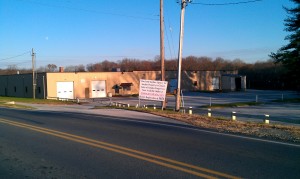Funding for RTVF equipment was always scarce. Even if an annual budget included funds earmarked for equipment purchases, one never knew if the Maryland Legislature would engage in some kind of budget tom-foolery and interfere with our plans. We wanted to expand the department’s equipment resources, and had no sure source of money. But we did have a secret weapon…
Gene Weiss
Gene was second to none when it came to gathering up still-decent “stuff” from far and wide. He kept his students well stocked in short-ends of film gleaned from his contacts in the local media. Somehow, he got the entire IATSE-built Soviet Arms Limitation Talks TV set delivered to the TV studios. Production houses and studios all over DC knew to contact him with “give-aways”, and all this spoke to the respect the RTVF department had accrued within the media community.
But the ace up Gene’s sleeve was the Maryland Surplus Property Disposal Unit in Jessup.
This facility received both State and Federal surplus property and housed it for distribution both to authorized users (Gene among them) as well as direct sale to the public. Gene would hear about a load of (say) Crown model 800 reel-to-reel machines on its way to Jessup, and he would swoop in and snatch them up. In this way, the RTVF department could go from one radio studio with a couple of reel-to-reel machines to a facilty with a quarter-inch editing room consisting of 8 machines, three radio studios each with a pair of quarter inch machines, 2 TV control rooms with a reel-to reel, and a shop-full of less desirable machines from which to pick spare parts.
There is an endless list of projectors, film cameras, amplifiers, monitors, recorders, test equipment, and so on that were the underpinnings of a very vibrant RTVF department. A truck known to all TV interns of a certain period as “The “Blue Bomber” was yet another Jessup procurement. Bob Swanner. drove the thing back from Jessup (sort of). The gas tank had plenty of water in it, because at some time during its storage, the gas cap had been removed. We simply coasted to the side of the road when it died, took off the cover on the carb, splashed the contents (water) out of the bowl, and continued on our way. When Bob made an engine-sputtering hard left turn into Campus Drive, the entire exhaust system became disconnected and slid all the way across University Boulevard. (You had to see this with your own eyes to appreciate it.) And does anyone remember that the State of Maryland had a film censor board? When the board ended it’s oversight of films exhibited in Maryland, Gene managed to snap up the two Simplex 35mm projectors that had been in the screening facility. He then could screen 35mm prints for his students.
There is absolutely no way that the department could have grown to its eventual size without the continuous efforts of Gene and others to obtain useful items at low or no cost.
